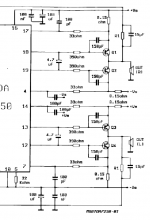I'm having a problem with the TDA chip when using 4 Ohm load. It seems the internal protection always comes on and cuts the sound off when I push the level higher. I'm using the same connection as in the manufacture's pdf file.
Also I'm currently developing a tube front for the TDA 7250 which promises to be very good as far as sound goes but I'll post a new thread as soon as it's done.
Can somebody help out with the load?
Also I'm currently developing a tube front for the TDA 7250 which promises to be very good as far as sound goes but I'll post a new thread as soon as it's done.
Can somebody help out with the load?
Current sense and overload potection pins are:
17, 4, 14, 7
These pins uses 0.15 Ohm resistors, between -V and +V
and these pins.
When voltage drop across these resistors ( 0.15 Ohm )
gets too high, current is limited.
You can try to lower the voltage drop.
Say make those 4 resistors 0.10 Ohm.
( 0.33 Ohm in parallel with 0.15 Ohm makes 0.103 Ohm )
Note:
If you have maximal voltage supply ( +- 45 Volt )
making resistors lower may make your amp overload and something can be destroyed.
If you are unlucky 🙂
If you are a real gambler, you can short out those 4 resistors.
Using a jumper wire instead of them.
This way the overload protection is disabled.
No need to tell this is at your own risk.
But there are DIY amps built with no or little safety or overload protection.
Also you can try increase value of them 100pF caps
sitting at those 4 pins.
Say to 220pF.
To try to filter away peaks that may trigger the protection.
Also if you search forum, you will find a few topics,
where members here have used TDA7250.
17, 4, 14, 7
These pins uses 0.15 Ohm resistors, between -V and +V
and these pins.
When voltage drop across these resistors ( 0.15 Ohm )
gets too high, current is limited.
You can try to lower the voltage drop.
Say make those 4 resistors 0.10 Ohm.
( 0.33 Ohm in parallel with 0.15 Ohm makes 0.103 Ohm )
Note:
If you have maximal voltage supply ( +- 45 Volt )
making resistors lower may make your amp overload and something can be destroyed.
If you are unlucky 🙂
If you are a real gambler, you can short out those 4 resistors.
Using a jumper wire instead of them.
This way the overload protection is disabled.
No need to tell this is at your own risk.
But there are DIY amps built with no or little safety or overload protection.
Also you can try increase value of them 100pF caps
sitting at those 4 pins.
Say to 220pF.
To try to filter away peaks that may trigger the protection.
Also if you search forum, you will find a few topics,
where members here have used TDA7250.
Attachments
Have a look at the datasheet. On page 3 it says that the capacitors at pins 3 and 8 work as integrator to control the quiescent current. They work together with the resistors at terminals 4, 7, 14 and 17.
The calculation bases are given on page 5.
The same goes for the current surveillance. Typical current comparator reference is 1 V for 10 µs, so 0,15 Ohm should lead to tripping at ~6,7 A peak, ~4,7 A eff, ~89W/4Ohm at all frequencies below 100 kHz. Choose those resistors according to the peak current of your transistors.
If you connect the 33 Ohm resistors directly to the rails you will still have the 0,15 Ohm resistors as protection for the transistors but no current limitation from the TDA7250. Most amplifiers work like that.
The calculation bases are given on page 5.
The same goes for the current surveillance. Typical current comparator reference is 1 V for 10 µs, so 0,15 Ohm should lead to tripping at ~6,7 A peak, ~4,7 A eff, ~89W/4Ohm at all frequencies below 100 kHz. Choose those resistors according to the peak current of your transistors.
If you connect the 33 Ohm resistors directly to the rails you will still have the 0,15 Ohm resistors as protection for the transistors but no current limitation from the TDA7250. Most amplifiers work like that.
- Status
- Not open for further replies.
